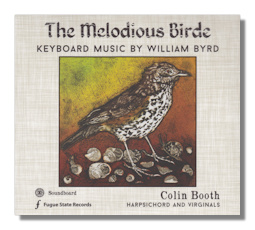
The Internet's Premier Classical Music Source
Related Links
-
Byrd Reviews
- Latest Reviews
- More Reviews
-
By Composer
-
Collections
DVD & Blu-ray
Books
Concert Reviews
Articles/Interviews
Software
Audio
Search Amazon
Recommended Links
Site News
 CD Review
CD Review
William Byrd

The Melodious Birde
- Lord Willoughby's Welcome Home
- Ground
- Third Pavan
- Third Galliard
- The Queen's Alman
- Fantasia
- Pavana
- Galiarda
- Ut, re, mi, fa, sol, la
- The Carman's Whistle
- Jhon Come Kisse Me Now
- Prelude
- Fantasia
- Pavana Ph. Tr.
- Galiarda
- Ground
- A Voluntarie for my ladye nevell
Colin Booth, Harpsichord & Virginals
Soundboard SBCD217
Accomplished player, keyboard instrument maker and teacher for 40 years, Colin Booth, presents a recital of a dozen and a half pieces of harpsichord and virginal music ranging in length from well under one minute to well over eight by the long-lived recusant composer of the English Renaissance, William Byrd.
The pieces all come from the Fitzwilliam Virginal Book, Musica Britannica or My Lady Nevell's Book. Byrd was a famed and prized keyboard virtuoso from early in his musical career, when an organist at Lincoln. Significantly, Byrd should be credited with forging a new range of instrumental genres. Before him, precious little music had been conceived specifically for the keyboard… rather, it was adapted from choral or dance music. But Booth's imaginative and technically astute playing gets to the heart of Byrd's creation in another way: by revealing the variety in which he tenaciously gloried. On this CD are sombre pieces, jolly ones, petulant and playful, thoughtful, sardonic and provoking, as well as dignified and measured. Above all genuinely melodious. Hence the CD's title.
It can be assumed that this spontaneity and liveliness originate in large part from the roots in improvisation which much of the music has. Equally crucial in Byrd's purpose was the wish to entertain and move the listener. The Pavans and Fantasies nay seem "occasional"; "casual" even. In fact they often have a spiritually rich import not far below their surface. Booth articulates this existence of several layers of musical expression very well. He refuses to get carried away by either the suggestion that a piece is only stately (like Ut, re, mi, fa, sol, la [tr.9]) or suggest that it tends to the purely simple (such as Jhon Come Kisse Me Now [tr.11]).
One of Colin Booth's greatest strengths as an interpreter of the keyboard music of Byrd is his curiosity. He opens each new piece, for example, with an almost quizzical care. Like the owner of an antiquarian bookshop eager to enter into the quest which each customer may have for books of all types… "now let's see what we have here". He sounds as intrigued by the next work as he was by the last. He gently and deliberately turns each page in the certainty that Byrd will not disappoint. And of course Byrd never does. In some ways this implies that Booth's approach is one of humility. Yet at the same time, his command of the music, its idiom and the best ways to present it to us is superb. Listen, for instance, to those seemingly endless runs at which Byrd excels – the "Fantasia" [tr.13], the longest work on the CD. Booth runs up and down the keyboard with great fluency and flexibility. It's as if the music follows him to make a completely compelling experience without ever drawing attention to its intricacies, actual compactness or underlying complexity.
This means that Booth's playing – while never hurried or anxious – squeezes much emotion, drama and life out of each piece by itself. He has not set out to "demonstrate" anything about Byrd other than that it's music to be listened to attentively and delighted in. He soon has us realizing just how much Byrd must have enjoyed writing and playing these works. This is no "romp" through this major swathe of Byrd's output, though. It's obvious that Booth has considered, tested, and refined carefully how he should approach each work; and then presented each with clarity and vision.
On the other hand, Booth feels no need to "re-interpret" Byrd. The great merit of this generous (the CD lasts over an hour and a quarter) recital is its adherence to the musical integrity of the composer. As if he were picking up first one delicate ornament, the another solid sculpture and examining each with us, finding in them as much wonder as he expects us to do. The Carman’s Whistle [tr.10] is a splendid example of the blend which Booth achieves between drive, rhythmic subtlety, poignancy and the certainty of an inspiration which both appears muted; yet is truly robust.
Color is important to Booth. Again, though, color is not an adjunct or "supplemental" dimension to the music. It's integral to conveying Byrd's intent. Booth makes it hard for us to imagine the music without the phrasing, holding back, without being continually conscious of the need for the variations in the Grounds to progress. Indeed, he has a distinct awareness of the overall direction which each piece takes. Given the fact that we know surprisingly little about Byrd's expectations for players' approaches to such notational conventions as the length of rests, tempi, and of course ornamentation, the results which Booth achieves are most satisfying.
The acoustic is dry – very dry – and breathily close. The bound-in booklet surveys the musical world of Byrd and his contemporaries under Elizabeth and James VI/I, the composer's wide and rich output with his keyboard works in particular, as well as notes on the performance, the three different instruments employed here, notation and – particularly illuminating – (Booth's approach to) ornamentation and tuning. If Byrd is somehow unfamiliar to you and you'd like to dip into his world, the variety, flexibility and appropriate expressiveness of Booth's choice of works here will make a good place to start.
Copyright © 2018, Mark Sealey












